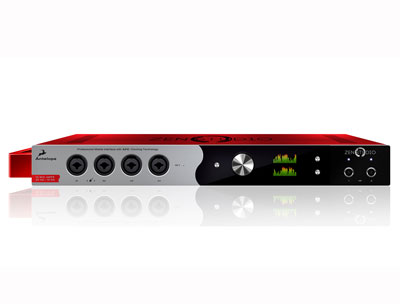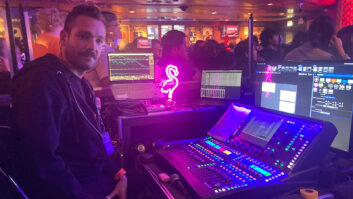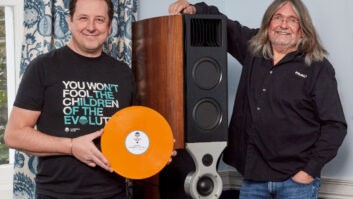
The audio interface market has been hot for a couple of years now, and it makes sense. When speeds and connections change in the computer industry, new products emerge in the audio industry. Nowhere is that more evident than on the front end, where there more than a few options to get audio into a recording system.
The range and features on audio interfaces today fit everyone’s need, from a beginning songwriter with two channels and no effects, to a multiroom facility with high-end units that incorporate built-in mixers, high-res converters and word clock in and out.
Here we take a look at a few recent 8-plus-channel units that include preamps. We’ve limited the selection to the past couple of years—that means there are plenty of quality units from the likes of Mackie, Tascam, Roland and others that you won’t find here. But if you are in the process of buying, you should check everything out.
Antelope Audio Zen Studio
Antelope Audio’s Zen Studio is a professional, portable audio interface with best-in-class analog and digital connectivity. The 12 world-class mic pre’s, Antelope’s signature clocking, the onboard DSP effects with multiple monitor mixers and the proprietary low-latency USB connectivity make Zen a world-class mobile recording system that can fit easily inside a backpack or gear bag. Zen Studio is designed to meet the needs of the modern day producer or engineer on-the-go, as well as location sound engineers, sound designers, independent bands and musicians in search of greater sound quality and flexibility.
Apogee Symphony I/O 8×8+8MP System
The biggest and baddest in the acclaimed Symphony line from Apogee, Symphony I/0 8×8+8MP with optional Thunderbolt connectivity is capable of 32×32 (all analog or a mixture of analog/digital). Features include: 8 inputs and outputs over a single 25-pin D-Sub, four Hi-Z 1/4-inch instrument inputs; eight built-in digitally controlled mic preamps; and selectable 48V phantom power, Soft Limit and phase invert.

Behringer U-PHORIA UMC1820
The Behringer U-PHORIA UMC1820 USB 2 audio interface, introduced at NAMM 2014, packs a lot of power for the money (about $200): 18 inputs and 10 outputs, MIDI I/O, eight Midas-designed mic pres (an additional eight via ADAT) and high-resolution 24-bit/96kHz converters. TRS, RCA, and XLR outputs for analog playback, and support for S/PDIF, ADAT, and S/MUX digital formats. Includes 48-volt phantom power, dual headphone outputs with separate level controls and monitor A/B source select for DJ-style cueing.

Focusrite Scarlett 18i20
The Focusrite Scarlett 18i20 is a 1U, USB 2 audio interface with 18 inputs and up to 20 outputs, and the same eight preamps and front panel controls as the Focusrite Saffire Pro 40 FireWire/Thunderbolt interface. It has MIDI in/out jacks, 24-bit/96kHz AD/DA converter chipsets, and works with any DAW by way of the included Scarlett MixControl software Version 1.3. There are eight Neutrik XLR Combo input jacks, plus TRS balanced and TS unbalanced line-level ¼-inch inputs and eight ADAT available. The back panel’s 20 outputs include two balanced TRS/TS analog main L/R monitor line outputs, eight more balanced analog TRS/TS outputs, an S/PDIF stereo out and ADAT Lightpipe for eight more digital outs. At sample rates 88.1/ 96 kHz, ADAT ins/outs are halved at four each.

M Audio M-Track Eight
This single-rackspace, eight-input USB 2 audio interface includes eight combo XLR+1/4-inch inputs, with phantom power switch, and inputs on the front panel that can be switched to instrument-level signals. Each input channel is equipped with Octane Preamp Technology, or line-input circuitry allows for external preamps. Two headphone outputs, located on the front panel, have their own level and selectable-source controls for creating custom headphone mixes.

MOTU 8M
This 24-in/24-out Hybrid Thunderbolt/USB 2 Audio Interface with eight mic pre’s includes V-Limit Clipping Protection, eight TRS outputs, ADAT and S/PDIF digital I/O, AVB Ethernet compatibility, and 48-channel DSP mixer. Each of the combo inputs accommodates balanced line-level and unbalanced instrument-level signal, with an additional 16 channels of I/O via ADAT optical ports. The Thunderbolt connection assures near-zero-latency monitoring. The digital mixer supports up to 48 inputs (via AVB expansion) and 12 stereo buses, for flexible routing schemes, studio or live, independent of the host computer.

PreSonus AudioBox 1818VSL
It’s about two years old now, but the AudioBox 1818VSL broke ground on its debut with its feature/price ratio. The company’s flagship single-rackspace USB 2 audio/MIDI interface is pro in every respect, down to its high-end 24/ 96 converters, eight Class-A XMAX preamps and word clock output. I/O includes two front-panel mic/instrument combo XLR-1/4-inch, six mic/line XLR-1/4-inch combos, two balanced ¼-inch line outs, eight balanced aux outs, and eight channels of ADAT optical I/O, with two channels SPDIF and headphone out. Also, true 48V phantom power. The power is in the Virtual Studio Live software, with 26×8 mixer, effects processing, and the acclaimed Fat Channel compression.

Prism Sound Atlas
Atlas from Prism Sound features their renowned performance, sound quality and state-of-the-art clock technology in a dedicated unit compatible with both Windows and MAC OS X. Once configured with a computer, Atlas can also operate stand-alone using its ADAT, S/PDIF or AES3 I/O. I/O includes 8x combo connectors with XLR sockets for mic input and 6.3mm TRS jack sockets for line input (balanced or unbalanced), 8x 6.3mm TRS jack sockets (balanced or unbalanced) plus Toslink, MIDI, word clock, Ethernet and USB I/O.

RME Fireface 802
The successor to the Fireface 800, the Fireface 802 offers up to 60 channels of audio including eight line inputs, four line-level mic/instrument inputs, and operation up to 192 kHz. Other features include ultra-low latency operation with USB or FireWire, active jitter suppression, individually switchable reference levels for all inputs and outputs, full stand-alone functionality, RME’s unique DIGICheck metering and analysis toolbox, and identical operation on Windows PC and Mac.

Steinberg UR824
This 24×24 rackmount, USB 2 audio interface from Steinberg features eight D-PRE preamps, 24-bit/192kHz operation with dspMixFx technology for latency-free monitoring with effects, also available as native VST 3 plug-ins. I/O includes eight XLR/TRS combo inputs, eight TRS line inputs, two pairs of ADAT I/O, USB, and word clock in and out. Each channel offers EQ and compression tools with the Sweet Spot Morphing Channel Strips. The UR824’s eight line outputs offer full support for surround productions up to 7.1. The UR824 introduces iPad connectivity and the free dspMixFx app, which offers the benefits of using Yamaha’s custom-designed SSP2 DSP chip directly on your iPad.

Universal Audio Apollo Twin Duo
Packing a lot into a small, desktop unit, the Apollo Twin Duo features 24-bit/192kHz operation at Thunderbolt speeds. With real-time UAD processing you can track through vintage Compressors, EQs, Tape Machines, and Guitar Amp plug-ins with close to zero latency. The unit features UA’s new Unison technology for stunning models of classic mic preamps and is available with either UAD-2 SOLO or UAD-2 DUO DSP Processing onboard. The unit ships with “Realtime Analog Classics” UAD plug-in bundle, two premium mic/line preamps; two line outs; front-panel Hi-Z instrument input and headphone output, and a digitally controlled analog monitor outputs for full resolution at all listening levels.

Zoom TAC-2
More than twice as fast as USB 3, the Zoom TAC-2 Thunderbolt interface was co-developed by Apple and Intel Labs. Features include Burr Brown PCM4202 A/D converters, AKM AK4396 D/A converters, two combo XLR/TRS mic/line inputs with phantom power, a front-panel hi-Z input, two balanced TRS outputs, and a dedicated ¼-inch stereo headphone jack. The TAC-2 MixEfx is an included Mac app designed specially for the TAC-2 allowing the user to set mix parameters and add time-based effects. Other features include a low cut filter, polarity reverse plus Auto Gain control for each input. The Loopback function allows you to blend the input signal and playback signal for ultra-low latency. A seven-position LED meter is onboard for input, output, and headphone volume metering.








